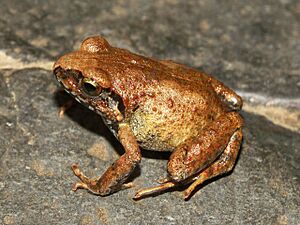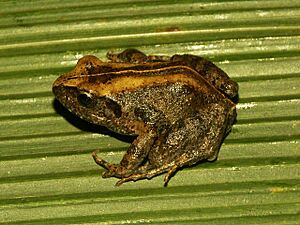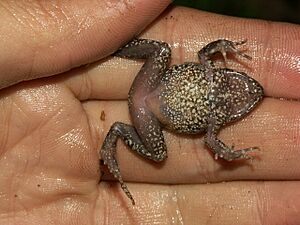Problem squeaker frog facts for kids
Quick facts for kids Problem squeaker frog |
|
|---|---|
 |
|
| Conservation status | |
| Scientific classification |
The Problem Squeaker Frog (Arthroleptis palava) is a small frog from the family Arthroleptidae. You can find it in the mountains of northern Cameroon and eastern Nigeria. Its name, palava, comes from a West African word meaning "problem." This name was chosen because this frog used to be confused with another similar frog, Arthroleptis poecilonotus.
Contents
What Does the Problem Squeaker Frog Look Like?
Male Problem Squeaker Frogs are about 22 to 24 millimeters long. This is less than an inch! Female frogs are a bit bigger, measuring 24 to 29 millimeters. This measurement is taken from their snout (nose) to their vent (bottom).
These frogs have strong bodies and sturdy legs. Their snout looks like a triangle when you view it from above. From the side, it looks blunt or rounded.
Skin and Colors
The frog's skin on its back can be light to medium brown. It often has small, dark brown or black spots. Some frogs even have a light cream stripe down the middle of their back.
The skin on their belly and throat is grey or white. It also has dark brown markings. The frog's eyes have a golden color with black squiggly lines.
Special Features
The frog's eardrum, called the tympanum, is easy to see. Its fingers and toes are thick with rounded, slightly swollen tips. These frogs do not have any webbing between their fingers or toes. The skin on the back of their belly is a bit bumpy and wrinkled.
Where Does This Frog Live?
The Problem Squeaker Frog lives in different places where people have changed the land. This includes tree farms and farmland. They also live in grasslands where animals graze. These frogs are found at high places, from about 1,000 to 1,900 meters (3,280 to 6,230 feet) above sea level.
Life Cycle
Scientists believe that these frogs have a special way of growing up. Unlike many frogs that lay eggs that hatch into tadpoles, the Problem Squeaker Frog likely develops directly. This means the eggs hatch into tiny froglets that look like small adults, skipping the tadpole stage. This is common for other frogs in the same family.
Conservation Status
The Problem Squeaker Frog is not currently in danger. It lives in many different environments, including places changed by humans. This wide range helps keep the species safe.




